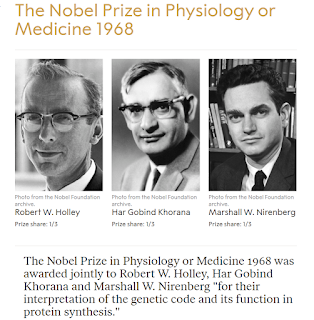--------------------------------------
Basic molecular code of life:
--------------------------------------
Genes on Chromosome in the cell nucleus carry instructions for amino acids in the form of chemical alphabets. They are four nitrogenous bases: A, G, T, C; namely Adenine, Guanine, Thymine, Cytosine. U (Uacil) is found only in RNA, replacing T.
These 4 nucleotides (A, G = Purines; T, C = Pyrimidines) of the DNA combine in various ways to form 3 letter code for any specific amino acid to the synthesis of protein.
Making of protein: Gene expression for the synthesis of protein is in two ways:
1. Transcription: Gene sequence of DNA strand is rewritten on mRNA with the help of transcriptase enzyme inside nucleus of the cell.
2. Translation: mRNA Nucleotide sequence is rewritten on tRNA with the help of polymerase enzyme, which in turn picks up a specific amino acid to form a polypeptide in Ribosome of the cell.
We encounter Codon and Anti Codon at the time of Translation.
Codon: A sequence of 3 nitrogenous Bases in a row on mRNA, as a message for the specific Amino acid.
Anti Codon: A sequence of 3 nitrogenous Bases in a row on tRNA on it's anti codon loop. They also have pseudo bases apart from the regular bases. These codon recognize the correct codon on mRNA by its complementary sequence.
Amino acid activation:
Amino acid + ATP --------> Amino acyl AMP +2Pi
Amino acyl + tRNA --------> Amino acyl tRNA +AMP
(tRNA loaded with Amino acid)
(cognate or charged tRNA)
Correct amino acid recognisation here by tRNA base (3' 5'), with complementary match with the base sequence on mRNA (5' 3').
-----------------------
Code crackers:
-----------------------
1. Physicist George Gamow in mid 1950s proposed the triplet hypothesis, this insight was mathematically suitable to code for essential 20 amino acids.
This three nucleotide triplet code was the minimum to cover all the amino acids, later proved correct.
2. American biochemists Marshall W. Nirenberg, Robert W. Holley, Hargobind Khorana in 1960s did the pioneering work. Nirenberg in 1961 with mRNA consisting poly-U, synthesized Phenylalanine (concluding UUU code for Phenylalanine) and later with poly-C mRNA translated to Proline (concluding CCC code for Proline).
Later Khorana experimented with poly-UC mRNA generated Serine and Leucine (concluding UCU code for Serine and CUC for Leucine).
In 1965 this code researcher team deciphered the entire genetic code, including stop code, initiation code and received Nobel Prize in 1968. (above modified image from nobel.org, in public domain)
----------------------------------------------------------------------------
Gregor Johann Mendel (1822-1884), Father of Genetics
-----------------------------------------------------------------------------
Mendel (Czech) did his experiments on 10,000 pea plants for eight years (1856-1863), published his results in 1865. He concluded that genes come in pair and inherited as distinct units, one from each parent. He tracked the segregation of parental genes and their appearance as dominant or recessive traits in offspring.
He clearly recognized the mathematical pattern of inheritance from one generation to the next.
Mendel's Laws of Heredity are:
1, The Law of Segregation,
2. The Law of Independent Assortment,
3. Law of Dominance.
After his death, most of his personal papers and documents were burnt by the monks except few which remained in the archive of monastery.
 |
| Mendel on a postal stamp |
His laws were not understood until 1900 when independently three Botanist namely Hugo de Vries (Netherland), Correns (Germany) and Tschermak (Austria) rediscovered the findings of Mendel. So Mendel put a blue print of things to come in the field of Genetics by deducing the laws of inheritance.
Meiosis, Chromosomes, Crossing Over, Genes, Linked Genes, Triplet Code were unknown in his time but his finding explains all this. His experimental results were rediscovered 16 years after his death and 34 years after he first published it. Triplet code came to be known only 100 years after his publication. Such was his genius as if he foresee all that. A friar, abbot who became 'Father', leaving no descendants behind, died at the age of 61 due to kidney ailment.






























